Analysis of Procter & Gamble: Management Economics Report (LCBB5003)
VerifiedAdded on 2023/01/09
|12
|3125
|84
Report
AI Summary
This report provides an in-depth analysis of Procter & Gamble (P&G), examining its history, products, and services within the fast-moving consumer goods (FMCG) sector. The report delves into P&G's market analysis since its inception, highlighting its evolution from an oligopoly to a monopolistic market structure. It explores the characteristics of oligopolistic and monopolistically competitive markets, discussing how P&G operates within these structures. The analysis includes the company's financial performance, market share, and the nature of the industry in which it operates. The report concludes by assessing whether operating in different market structures is optimal for P&G, providing insights into its strategic positioning and competitive advantages within the global market. The report covers different aspects of the company like its background, market structure, and the industry in which it operates, with a specific focus on its baby wipes product.
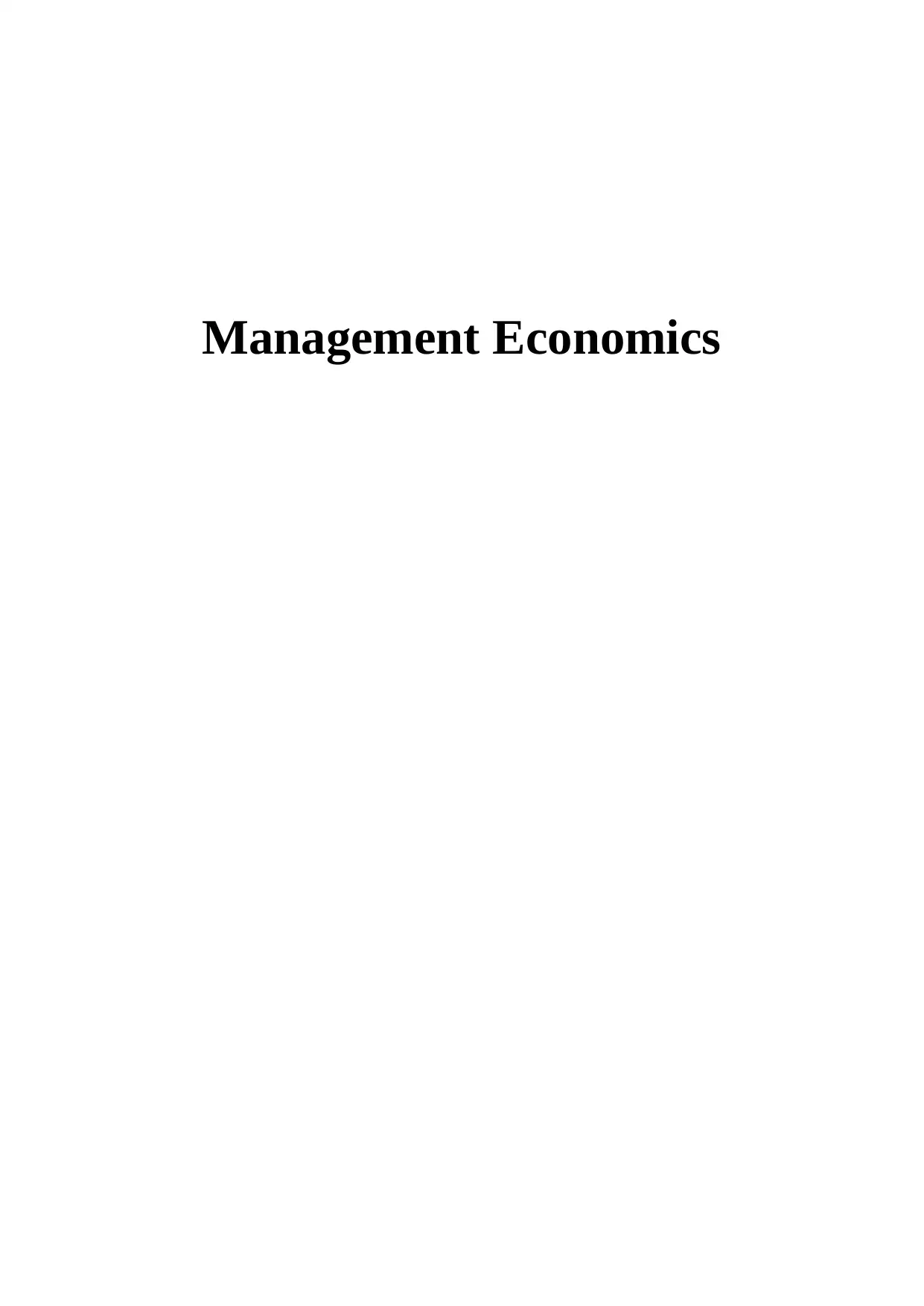
Management Economics
Paraphrase This Document
Need a fresh take? Get an instant paraphrase of this document with our AI Paraphraser
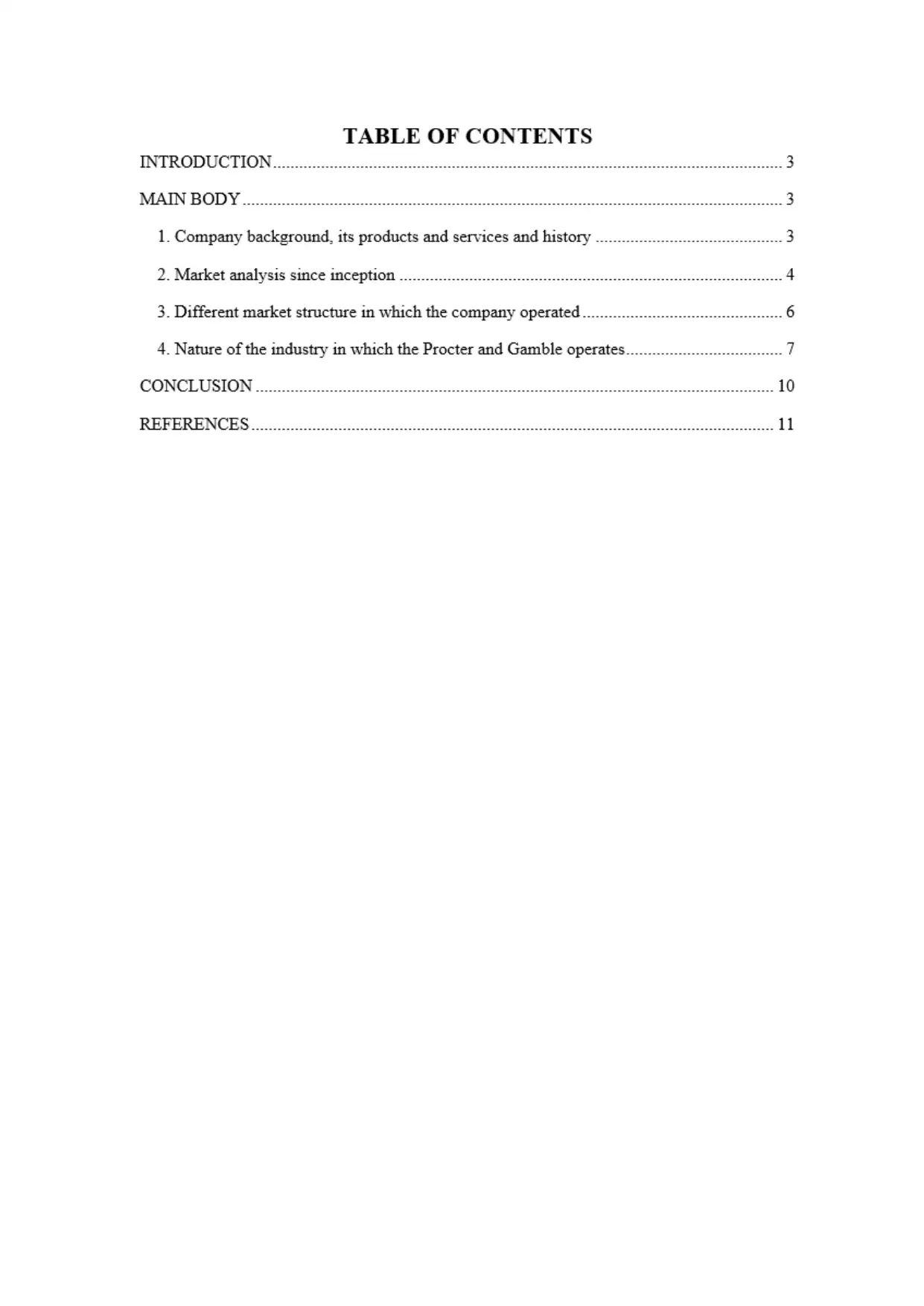
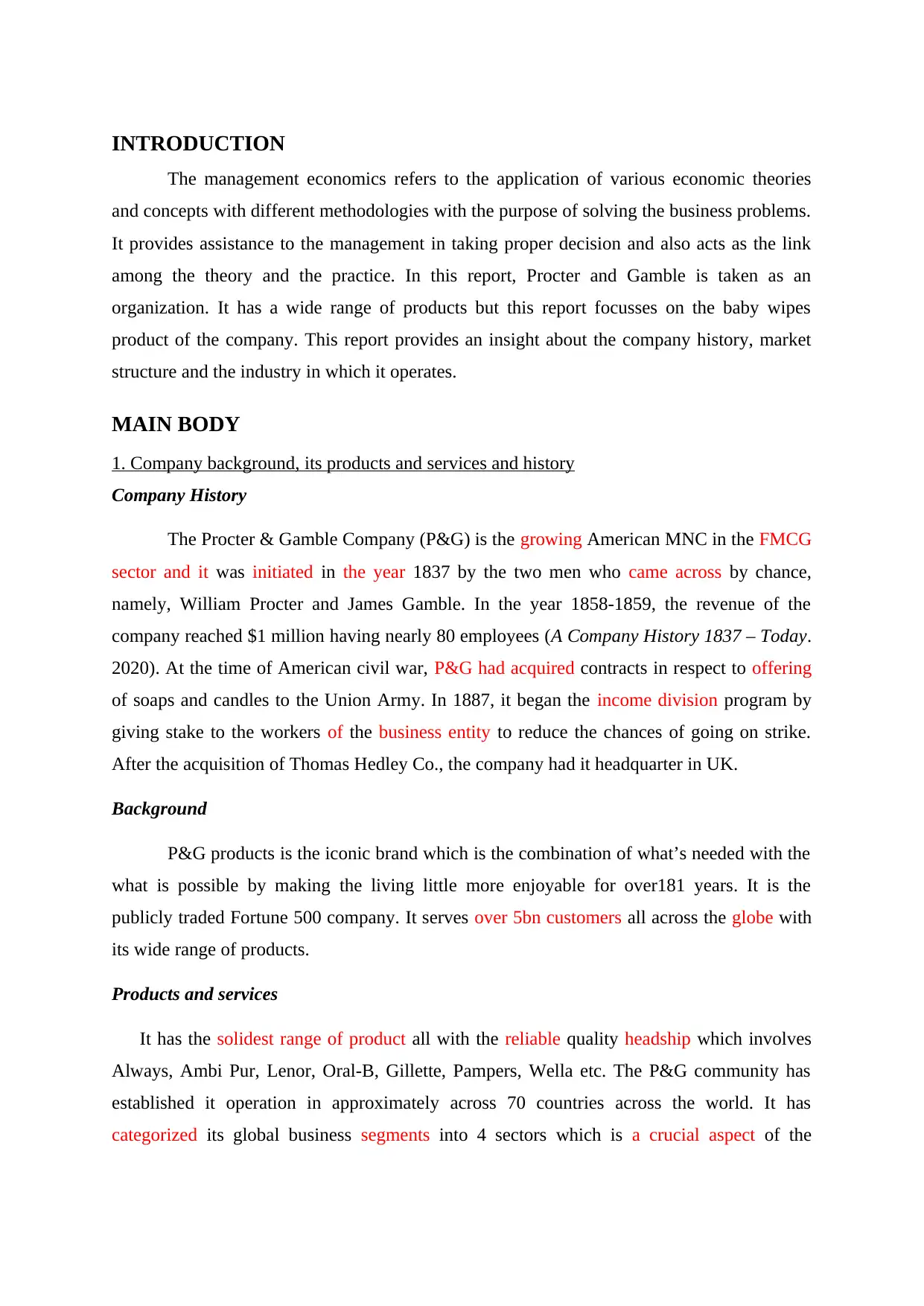
INTRODUCTION
The management economics refers to the application of various economic theories
and concepts with different methodologies with the purpose of solving the business problems.
It provides assistance to the management in taking proper decision and also acts as the link
among the theory and the practice. In this report, Procter and Gamble is taken as an
organization. It has a wide range of products but this report focusses on the baby wipes
product of the company. This report provides an insight about the company history, market
structure and the industry in which it operates.
MAIN BODY
1. Company background, its products and services and history
Company History
The Procter & Gamble Company (P&G) is the growing American MNC in the FMCG
sector and it was initiated in the year 1837 by the two men who came across by chance,
namely, William Procter and James Gamble. In the year 1858-1859, the revenue of the
company reached $1 million having nearly 80 employees (A Company History 1837 – Today.
2020). At the time of American civil war, P&G had acquired contracts in respect to offering
of soaps and candles to the Union Army. In 1887, it began the income division program by
giving stake to the workers of the business entity to reduce the chances of going on strike.
After the acquisition of Thomas Hedley Co., the company had it headquarter in UK.
Background
P&G products is the iconic brand which is the combination of what’s needed with the
what is possible by making the living little more enjoyable for over181 years. It is the
publicly traded Fortune 500 company. It serves over 5bn customers all across the globe with
its wide range of products.
Products and services
It has the solidest range of product all with the reliable quality headship which involves
Always, Ambi Pur, Lenor, Oral-B, Gillette, Pampers, Wella etc. The P&G community has
established it operation in approximately across 70 countries across the world. It has
categorized its global business segments into 4 sectors which is a crucial aspect of the
The management economics refers to the application of various economic theories
and concepts with different methodologies with the purpose of solving the business problems.
It provides assistance to the management in taking proper decision and also acts as the link
among the theory and the practice. In this report, Procter and Gamble is taken as an
organization. It has a wide range of products but this report focusses on the baby wipes
product of the company. This report provides an insight about the company history, market
structure and the industry in which it operates.
MAIN BODY
1. Company background, its products and services and history
Company History
The Procter & Gamble Company (P&G) is the growing American MNC in the FMCG
sector and it was initiated in the year 1837 by the two men who came across by chance,
namely, William Procter and James Gamble. In the year 1858-1859, the revenue of the
company reached $1 million having nearly 80 employees (A Company History 1837 – Today.
2020). At the time of American civil war, P&G had acquired contracts in respect to offering
of soaps and candles to the Union Army. In 1887, it began the income division program by
giving stake to the workers of the business entity to reduce the chances of going on strike.
After the acquisition of Thomas Hedley Co., the company had it headquarter in UK.
Background
P&G products is the iconic brand which is the combination of what’s needed with the
what is possible by making the living little more enjoyable for over181 years. It is the
publicly traded Fortune 500 company. It serves over 5bn customers all across the globe with
its wide range of products.
Products and services
It has the solidest range of product all with the reliable quality headship which involves
Always, Ambi Pur, Lenor, Oral-B, Gillette, Pampers, Wella etc. The P&G community has
established it operation in approximately across 70 countries across the world. It has
categorized its global business segments into 4 sectors which is a crucial aspect of the
⊘ This is a preview!⊘
Do you want full access?
Subscribe today to unlock all pages.

Trusted by 1+ million students worldwide
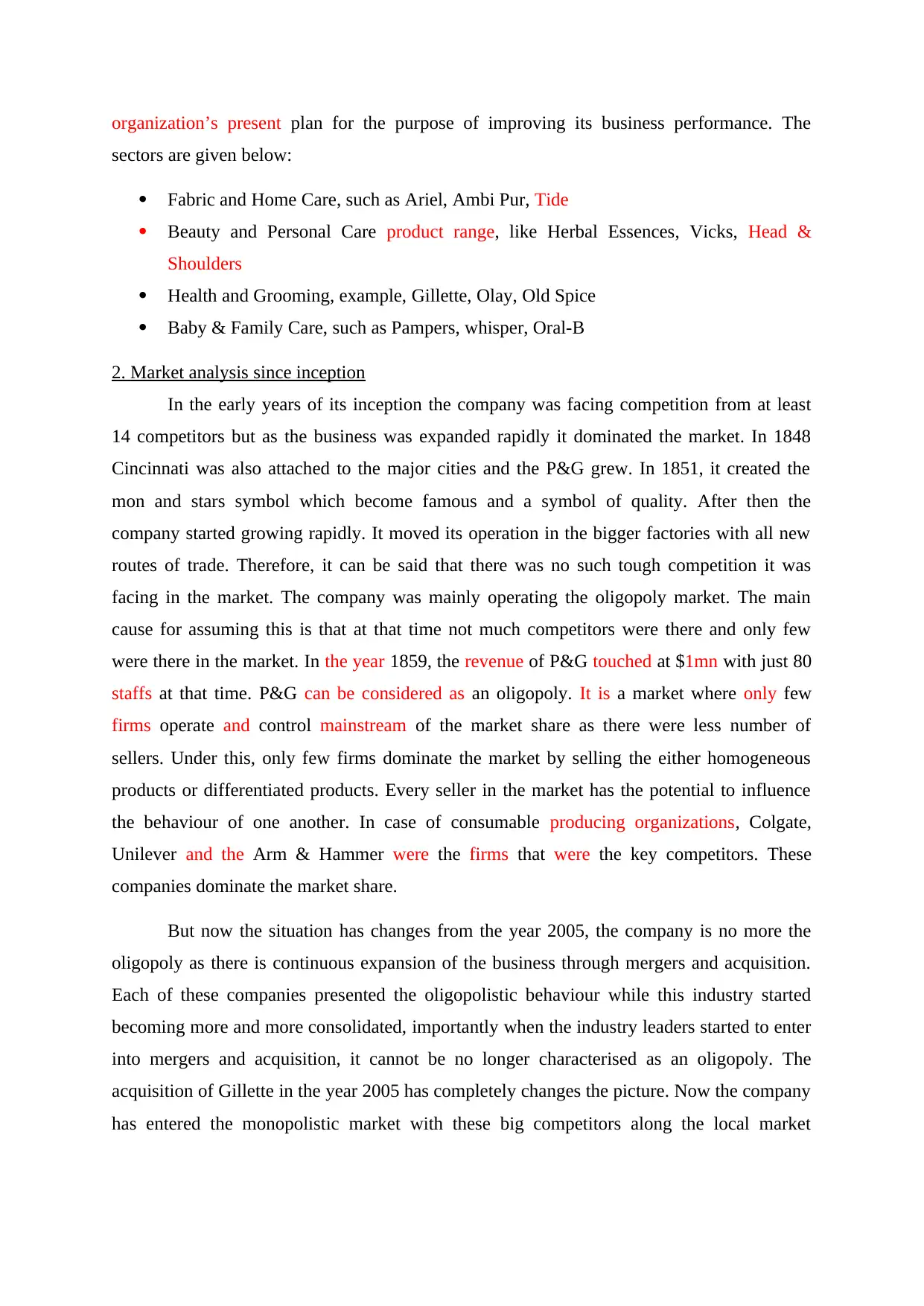
organization’s present plan for the purpose of improving its business performance. The
sectors are given below:
Fabric and Home Care, such as Ariel, Ambi Pur, Tide
Beauty and Personal Care product range, like Herbal Essences, Vicks, Head &
Shoulders
Health and Grooming, example, Gillette, Olay, Old Spice
Baby & Family Care, such as Pampers, whisper, Oral-B
2. Market analysis since inception
In the early years of its inception the company was facing competition from at least
14 competitors but as the business was expanded rapidly it dominated the market. In 1848
Cincinnati was also attached to the major cities and the P&G grew. In 1851, it created the
mon and stars symbol which become famous and a symbol of quality. After then the
company started growing rapidly. It moved its operation in the bigger factories with all new
routes of trade. Therefore, it can be said that there was no such tough competition it was
facing in the market. The company was mainly operating the oligopoly market. The main
cause for assuming this is that at that time not much competitors were there and only few
were there in the market. In the year 1859, the revenue of P&G touched at $1mn with just 80
staffs at that time. P&G can be considered as an oligopoly. It is a market where only few
firms operate and control mainstream of the market share as there were less number of
sellers. Under this, only few firms dominate the market by selling the either homogeneous
products or differentiated products. Every seller in the market has the potential to influence
the behaviour of one another. In case of consumable producing organizations, Colgate,
Unilever and the Arm & Hammer were the firms that were the key competitors. These
companies dominate the market share.
But now the situation has changes from the year 2005, the company is no more the
oligopoly as there is continuous expansion of the business through mergers and acquisition.
Each of these companies presented the oligopolistic behaviour while this industry started
becoming more and more consolidated, importantly when the industry leaders started to enter
into mergers and acquisition, it cannot be no longer characterised as an oligopoly. The
acquisition of Gillette in the year 2005 has completely changes the picture. Now the company
has entered the monopolistic market with these big competitors along the local market
sectors are given below:
Fabric and Home Care, such as Ariel, Ambi Pur, Tide
Beauty and Personal Care product range, like Herbal Essences, Vicks, Head &
Shoulders
Health and Grooming, example, Gillette, Olay, Old Spice
Baby & Family Care, such as Pampers, whisper, Oral-B
2. Market analysis since inception
In the early years of its inception the company was facing competition from at least
14 competitors but as the business was expanded rapidly it dominated the market. In 1848
Cincinnati was also attached to the major cities and the P&G grew. In 1851, it created the
mon and stars symbol which become famous and a symbol of quality. After then the
company started growing rapidly. It moved its operation in the bigger factories with all new
routes of trade. Therefore, it can be said that there was no such tough competition it was
facing in the market. The company was mainly operating the oligopoly market. The main
cause for assuming this is that at that time not much competitors were there and only few
were there in the market. In the year 1859, the revenue of P&G touched at $1mn with just 80
staffs at that time. P&G can be considered as an oligopoly. It is a market where only few
firms operate and control mainstream of the market share as there were less number of
sellers. Under this, only few firms dominate the market by selling the either homogeneous
products or differentiated products. Every seller in the market has the potential to influence
the behaviour of one another. In case of consumable producing organizations, Colgate,
Unilever and the Arm & Hammer were the firms that were the key competitors. These
companies dominate the market share.
But now the situation has changes from the year 2005, the company is no more the
oligopoly as there is continuous expansion of the business through mergers and acquisition.
Each of these companies presented the oligopolistic behaviour while this industry started
becoming more and more consolidated, importantly when the industry leaders started to enter
into mergers and acquisition, it cannot be no longer characterised as an oligopoly. The
acquisition of Gillette in the year 2005 has completely changes the picture. Now the company
has entered the monopolistic market with these big competitors along the local market
Paraphrase This Document
Need a fresh take? Get an instant paraphrase of this document with our AI Paraphraser
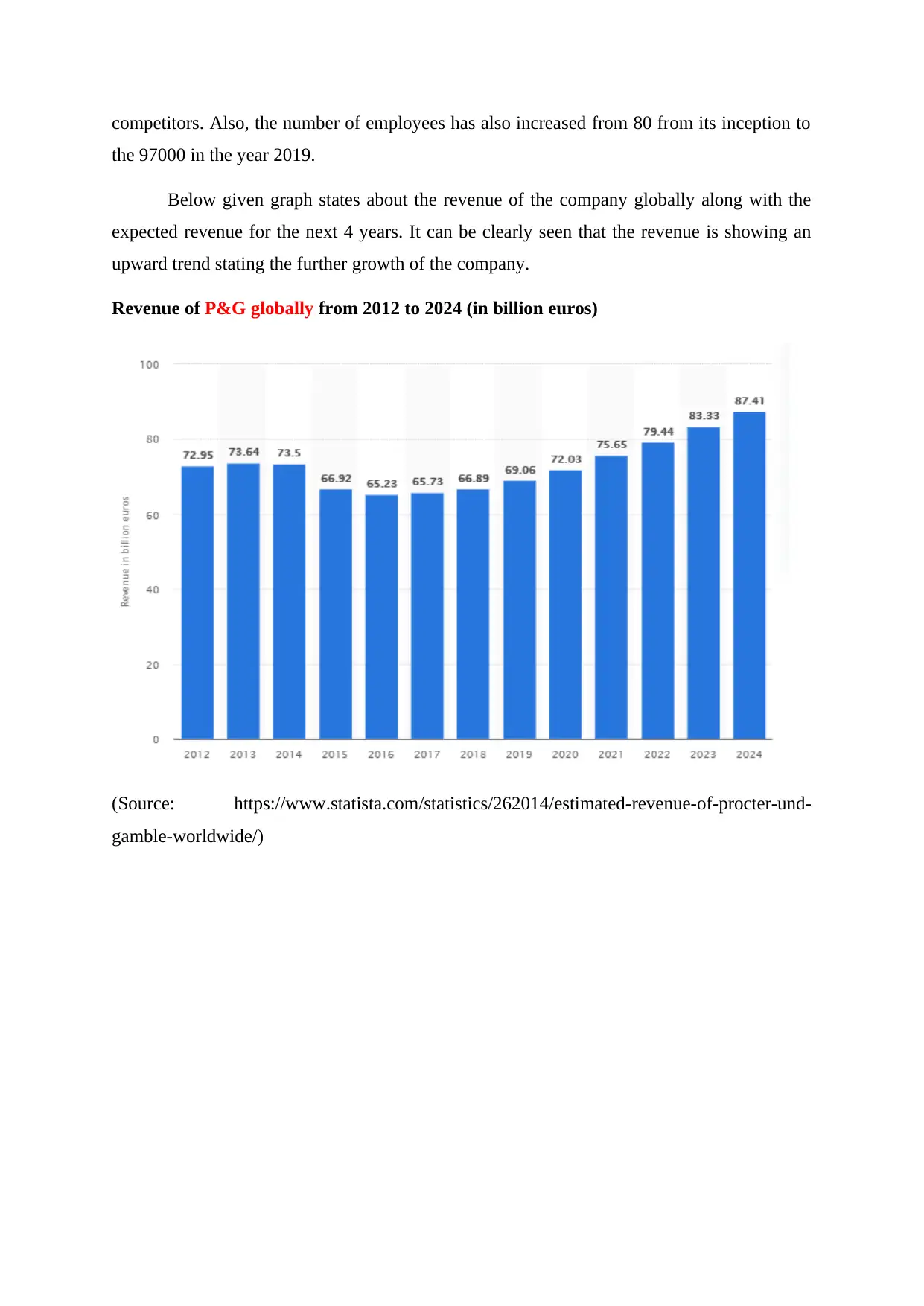
competitors. Also, the number of employees has also increased from 80 from its inception to
the 97000 in the year 2019.
Below given graph states about the revenue of the company globally along with the
expected revenue for the next 4 years. It can be clearly seen that the revenue is showing an
upward trend stating the further growth of the company.
Revenue of P&G globally from 2012 to 2024 (in billion euros)
(Source: https://www.statista.com/statistics/262014/estimated-revenue-of-procter-und-
gamble-worldwide/)
the 97000 in the year 2019.
Below given graph states about the revenue of the company globally along with the
expected revenue for the next 4 years. It can be clearly seen that the revenue is showing an
upward trend stating the further growth of the company.
Revenue of P&G globally from 2012 to 2024 (in billion euros)
(Source: https://www.statista.com/statistics/262014/estimated-revenue-of-procter-und-
gamble-worldwide/)
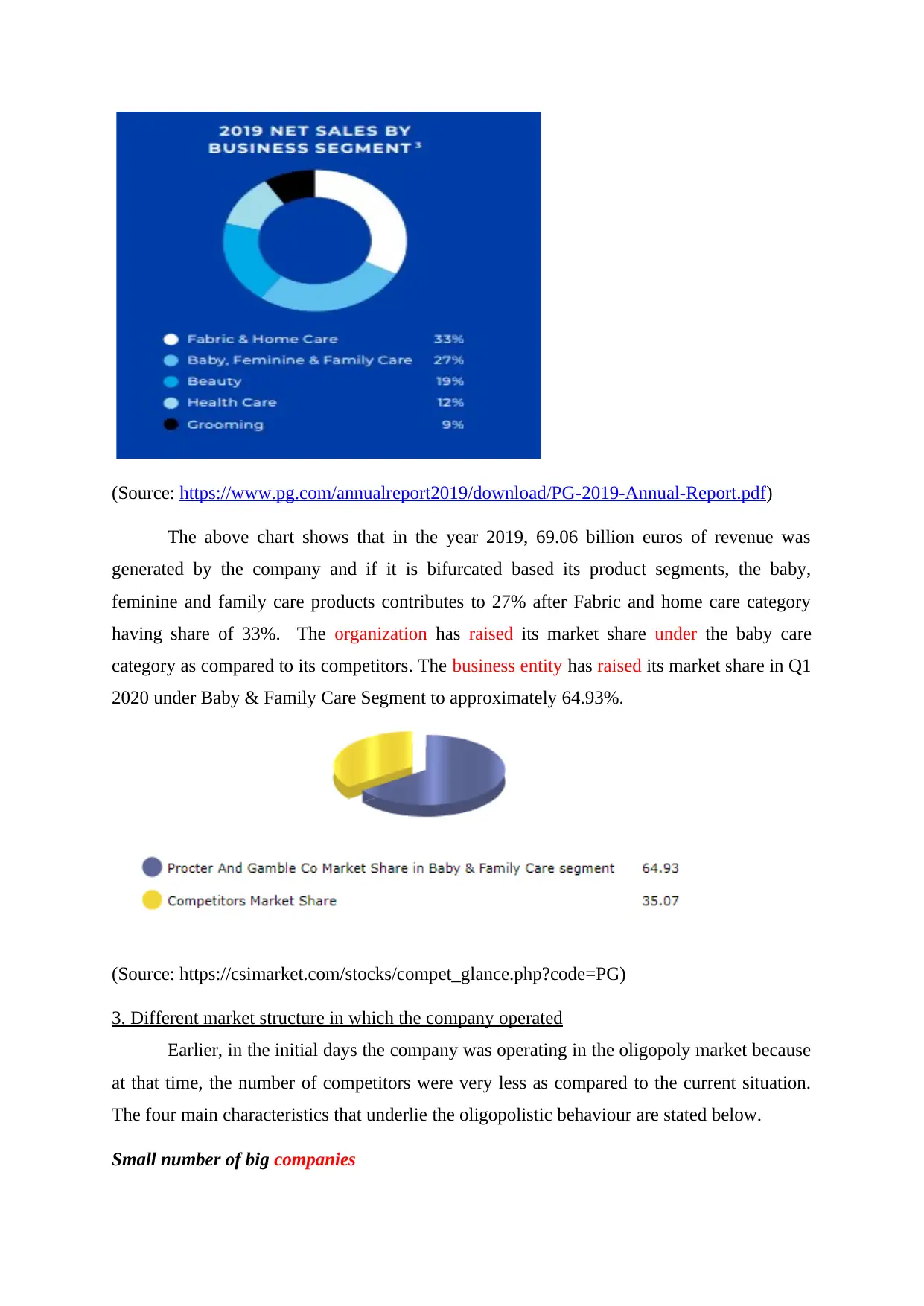
(Source: https://www.pg.com/annualreport2019/download/PG-2019-Annual-Report.pdf)
The above chart shows that in the year 2019, 69.06 billion euros of revenue was
generated by the company and if it is bifurcated based its product segments, the baby,
feminine and family care products contributes to 27% after Fabric and home care category
having share of 33%. The organization has raised its market share under the baby care
category as compared to its competitors. The business entity has raised its market share in Q1
2020 under Baby & Family Care Segment to approximately 64.93%.
(Source: https://csimarket.com/stocks/compet_glance.php?code=PG)
3. Different market structure in which the company operated
Earlier, in the initial days the company was operating in the oligopoly market because
at that time, the number of competitors were very less as compared to the current situation.
The four main characteristics that underlie the oligopolistic behaviour are stated below.
Small number of big companies
The above chart shows that in the year 2019, 69.06 billion euros of revenue was
generated by the company and if it is bifurcated based its product segments, the baby,
feminine and family care products contributes to 27% after Fabric and home care category
having share of 33%. The organization has raised its market share under the baby care
category as compared to its competitors. The business entity has raised its market share in Q1
2020 under Baby & Family Care Segment to approximately 64.93%.
(Source: https://csimarket.com/stocks/compet_glance.php?code=PG)
3. Different market structure in which the company operated
Earlier, in the initial days the company was operating in the oligopoly market because
at that time, the number of competitors were very less as compared to the current situation.
The four main characteristics that underlie the oligopolistic behaviour are stated below.
Small number of big companies
⊘ This is a preview!⊘
Do you want full access?
Subscribe today to unlock all pages.

Trusted by 1+ million students worldwide

The most pivotal quality of the oligopoly is that the business is ruled by the less
number of enormous firms and every one of which is huge enough in regard to the general
size of the market. This characteristic provides each and every large firm a substantial
amount of control over the market not as much as under monopoly (Tomohiro and
Hongyong, 2019). Having large firms makes the industry monopolistically competitive in
nature. The only unique factor is that only few of the companies in the market are huge. P&G
initially were having very less competitors such as L'Oreal, Unilever, Colgate-Palmolive and
some more.
Matching or distinguished Products
Under oligopolistic market conditions, some industries yield homogeneous items just
as in the perfect competition, on the other hand, some industries produce the differentiated
products as in case of monopolistic competition. In simple words, it states that the
oligopolistic industries come in 2 types which are stated below.
Identical Product Oligopoly: Under this oligopoly, the focus is on the processing of the raw
material or the production of the intermediate goods which is further utilized by the industries
as the input.
Differentiate Product Oligopoly: Under this type of oligopoly, will in general focusses on the
merchandise sold for singular usage. The key is that people have various wants and
preferences and therefore enjoys everything. A couple of instances of this type of
oligopolistic businesses incorporate automobiles, cleansers and cleansing agent and PCs.
Barriers to Entry
The organizations under this oligopolistic industry deals with accomplishing and
holding the market control through barriers to entry. The barriers are related to exclusive are
identified with selective asset possession, licenses and copyrights and other legitimate
limitations and the higher start up cost. So there are the certain factor that poses entry barriers
in this market structure (Nocke and Schutz, 2018). The entrance barriers are the major
characteristics that actually distinguishes the oligopoly market from monopolistic market on
the variety of market structures. Therefore, it makes problematic for the newly established
firms to enter the oligopoly market as the result of the substantial barrier persisting in the
market which makes the existing firms in the market to remain competitive and have greater
control. Also, it makes the large firm enjoy the benefit of economies of scale.
number of enormous firms and every one of which is huge enough in regard to the general
size of the market. This characteristic provides each and every large firm a substantial
amount of control over the market not as much as under monopoly (Tomohiro and
Hongyong, 2019). Having large firms makes the industry monopolistically competitive in
nature. The only unique factor is that only few of the companies in the market are huge. P&G
initially were having very less competitors such as L'Oreal, Unilever, Colgate-Palmolive and
some more.
Matching or distinguished Products
Under oligopolistic market conditions, some industries yield homogeneous items just
as in the perfect competition, on the other hand, some industries produce the differentiated
products as in case of monopolistic competition. In simple words, it states that the
oligopolistic industries come in 2 types which are stated below.
Identical Product Oligopoly: Under this oligopoly, the focus is on the processing of the raw
material or the production of the intermediate goods which is further utilized by the industries
as the input.
Differentiate Product Oligopoly: Under this type of oligopoly, will in general focusses on the
merchandise sold for singular usage. The key is that people have various wants and
preferences and therefore enjoys everything. A couple of instances of this type of
oligopolistic businesses incorporate automobiles, cleansers and cleansing agent and PCs.
Barriers to Entry
The organizations under this oligopolistic industry deals with accomplishing and
holding the market control through barriers to entry. The barriers are related to exclusive are
identified with selective asset possession, licenses and copyrights and other legitimate
limitations and the higher start up cost. So there are the certain factor that poses entry barriers
in this market structure (Nocke and Schutz, 2018). The entrance barriers are the major
characteristics that actually distinguishes the oligopoly market from monopolistic market on
the variety of market structures. Therefore, it makes problematic for the newly established
firms to enter the oligopoly market as the result of the substantial barrier persisting in the
market which makes the existing firms in the market to remain competitive and have greater
control. Also, it makes the large firm enjoy the benefit of economies of scale.
Paraphrase This Document
Need a fresh take? Get an instant paraphrase of this document with our AI Paraphraser
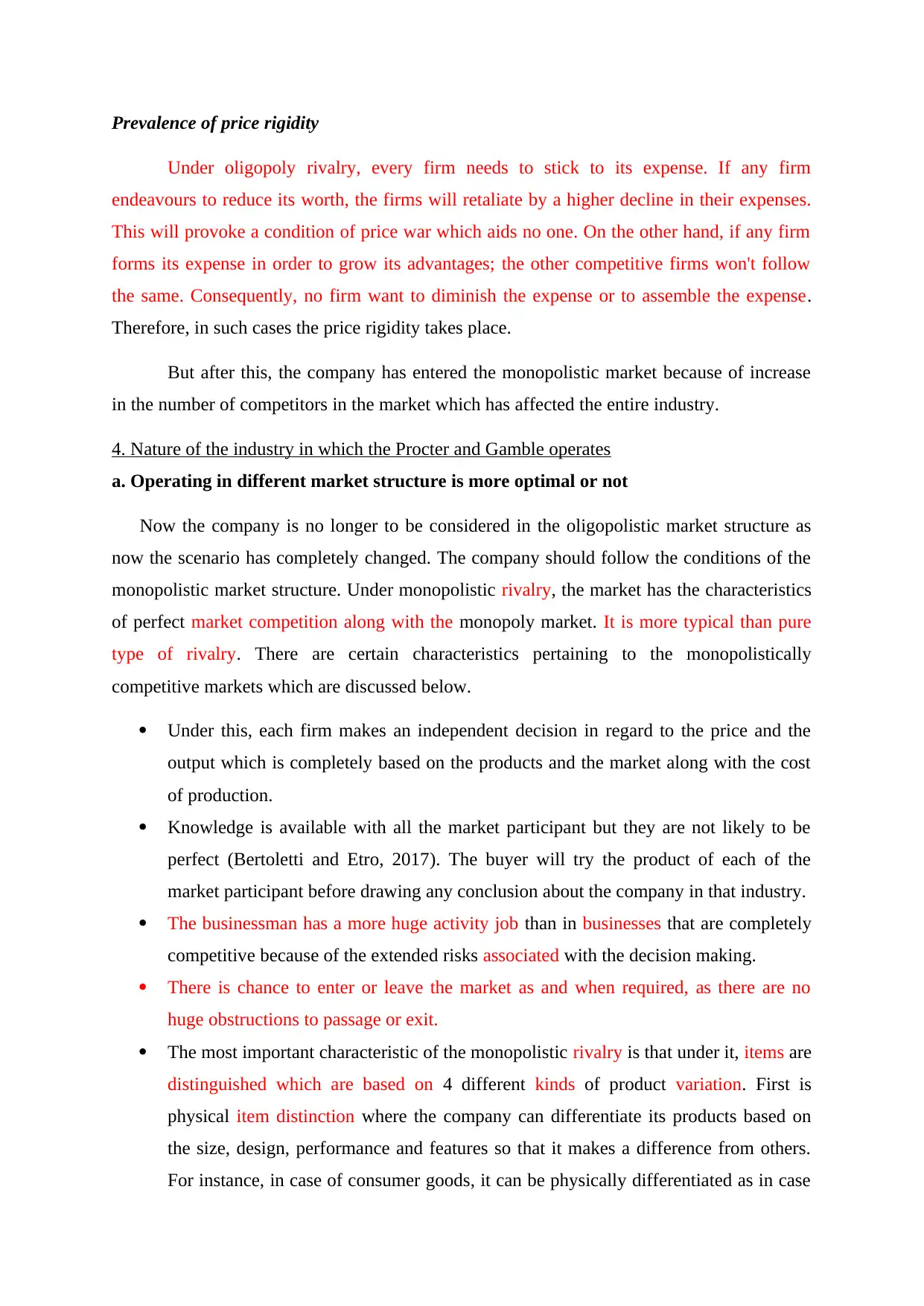
Prevalence of price rigidity
Under oligopoly rivalry, every firm needs to stick to its expense. If any firm
endeavours to reduce its worth, the firms will retaliate by a higher decline in their expenses.
This will provoke a condition of price war which aids no one. On the other hand, if any firm
forms its expense in order to grow its advantages; the other competitive firms won't follow
the same. Consequently, no firm want to diminish the expense or to assemble the expense.
Therefore, in such cases the price rigidity takes place.
But after this, the company has entered the monopolistic market because of increase
in the number of competitors in the market which has affected the entire industry.
4. Nature of the industry in which the Procter and Gamble operates
a. Operating in different market structure is more optimal or not
Now the company is no longer to be considered in the oligopolistic market structure as
now the scenario has completely changed. The company should follow the conditions of the
monopolistic market structure. Under monopolistic rivalry, the market has the characteristics
of perfect market competition along with the monopoly market. It is more typical than pure
type of rivalry. There are certain characteristics pertaining to the monopolistically
competitive markets which are discussed below.
Under this, each firm makes an independent decision in regard to the price and the
output which is completely based on the products and the market along with the cost
of production.
Knowledge is available with all the market participant but they are not likely to be
perfect (Bertoletti and Etro, 2017). The buyer will try the product of each of the
market participant before drawing any conclusion about the company in that industry.
The businessman has a more huge activity job than in businesses that are completely
competitive because of the extended risks associated with the decision making.
There is chance to enter or leave the market as and when required, as there are no
huge obstructions to passage or exit.
The most important characteristic of the monopolistic rivalry is that under it, items are
distinguished which are based on 4 different kinds of product variation. First is
physical item distinction where the company can differentiate its products based on
the size, design, performance and features so that it makes a difference from others.
For instance, in case of consumer goods, it can be physically differentiated as in case
Under oligopoly rivalry, every firm needs to stick to its expense. If any firm
endeavours to reduce its worth, the firms will retaliate by a higher decline in their expenses.
This will provoke a condition of price war which aids no one. On the other hand, if any firm
forms its expense in order to grow its advantages; the other competitive firms won't follow
the same. Consequently, no firm want to diminish the expense or to assemble the expense.
Therefore, in such cases the price rigidity takes place.
But after this, the company has entered the monopolistic market because of increase
in the number of competitors in the market which has affected the entire industry.
4. Nature of the industry in which the Procter and Gamble operates
a. Operating in different market structure is more optimal or not
Now the company is no longer to be considered in the oligopolistic market structure as
now the scenario has completely changed. The company should follow the conditions of the
monopolistic market structure. Under monopolistic rivalry, the market has the characteristics
of perfect market competition along with the monopoly market. It is more typical than pure
type of rivalry. There are certain characteristics pertaining to the monopolistically
competitive markets which are discussed below.
Under this, each firm makes an independent decision in regard to the price and the
output which is completely based on the products and the market along with the cost
of production.
Knowledge is available with all the market participant but they are not likely to be
perfect (Bertoletti and Etro, 2017). The buyer will try the product of each of the
market participant before drawing any conclusion about the company in that industry.
The businessman has a more huge activity job than in businesses that are completely
competitive because of the extended risks associated with the decision making.
There is chance to enter or leave the market as and when required, as there are no
huge obstructions to passage or exit.
The most important characteristic of the monopolistic rivalry is that under it, items are
distinguished which are based on 4 different kinds of product variation. First is
physical item distinction where the company can differentiate its products based on
the size, design, performance and features so that it makes a difference from others.
For instance, in case of consumer goods, it can be physically differentiated as in case

of Procter and Gamble as it has differentiated its products based on size and looks
(Monopolistic competition. 2020). Second is marketing differentiation, in this product
are distinguished from the competitor’s product through distinctive packaging along
with further additional advertising techniques. Human capital difference, where the
organizations makes contrasts over the expertise of its representatives, the degree of
exercise provided, unique attires etc. Last is distribution distinction, in which the
products are being distributed out through other means other than traditional method
such as Procter and gamble provides its products through e-commerce websites like
amazon and other similar platforms.
The organizations are price maker and faces descending sloping bend. Since every
company makes a unique of a kind item, it can take a sequential price as compared to
its opponents. The organization can set its own cost and does not require to acquire it
from the business overall, however the industry cost might be considered as a
guideline, or turning it into a constraint. This additionally implies the demand graph
will bend sloping downward.
Businesses working under monopolistic competition for the most part need to
participate in publicizing or promoting. Firms are every now and again in savage
contention with another (local) firms offering a tantamount thing or service, and may
need to plug on a local premise, to tell customers their differences (Bertoletti and
Etro, 2016). Common strategies for publicizing for these organizations includes media
and radio, local film, banners, handouts and various other promotion techniques.
Monopolistically rivalry organizations are thought to be advantage maximisers since
firms will by and large be little with entrepreneurs successfully connected with
dealing with the business.
Under this, the firms are commonly countless independent firms competing in the
market.
Therefore, looking at all these benefits it is seems to be advantageous for the Procter and
gamble to be operating in the monopolistic market.
b. Level of government intervention
It is considered preferable to have a moderate intervention of the government in the
business operation. But it is essential to have government intervention as it will help in
(Monopolistic competition. 2020). Second is marketing differentiation, in this product
are distinguished from the competitor’s product through distinctive packaging along
with further additional advertising techniques. Human capital difference, where the
organizations makes contrasts over the expertise of its representatives, the degree of
exercise provided, unique attires etc. Last is distribution distinction, in which the
products are being distributed out through other means other than traditional method
such as Procter and gamble provides its products through e-commerce websites like
amazon and other similar platforms.
The organizations are price maker and faces descending sloping bend. Since every
company makes a unique of a kind item, it can take a sequential price as compared to
its opponents. The organization can set its own cost and does not require to acquire it
from the business overall, however the industry cost might be considered as a
guideline, or turning it into a constraint. This additionally implies the demand graph
will bend sloping downward.
Businesses working under monopolistic competition for the most part need to
participate in publicizing or promoting. Firms are every now and again in savage
contention with another (local) firms offering a tantamount thing or service, and may
need to plug on a local premise, to tell customers their differences (Bertoletti and
Etro, 2016). Common strategies for publicizing for these organizations includes media
and radio, local film, banners, handouts and various other promotion techniques.
Monopolistically rivalry organizations are thought to be advantage maximisers since
firms will by and large be little with entrepreneurs successfully connected with
dealing with the business.
Under this, the firms are commonly countless independent firms competing in the
market.
Therefore, looking at all these benefits it is seems to be advantageous for the Procter and
gamble to be operating in the monopolistic market.
b. Level of government intervention
It is considered preferable to have a moderate intervention of the government in the
business operation. But it is essential to have government intervention as it will help in
⊘ This is a preview!⊘
Do you want full access?
Subscribe today to unlock all pages.

Trusted by 1+ million students worldwide
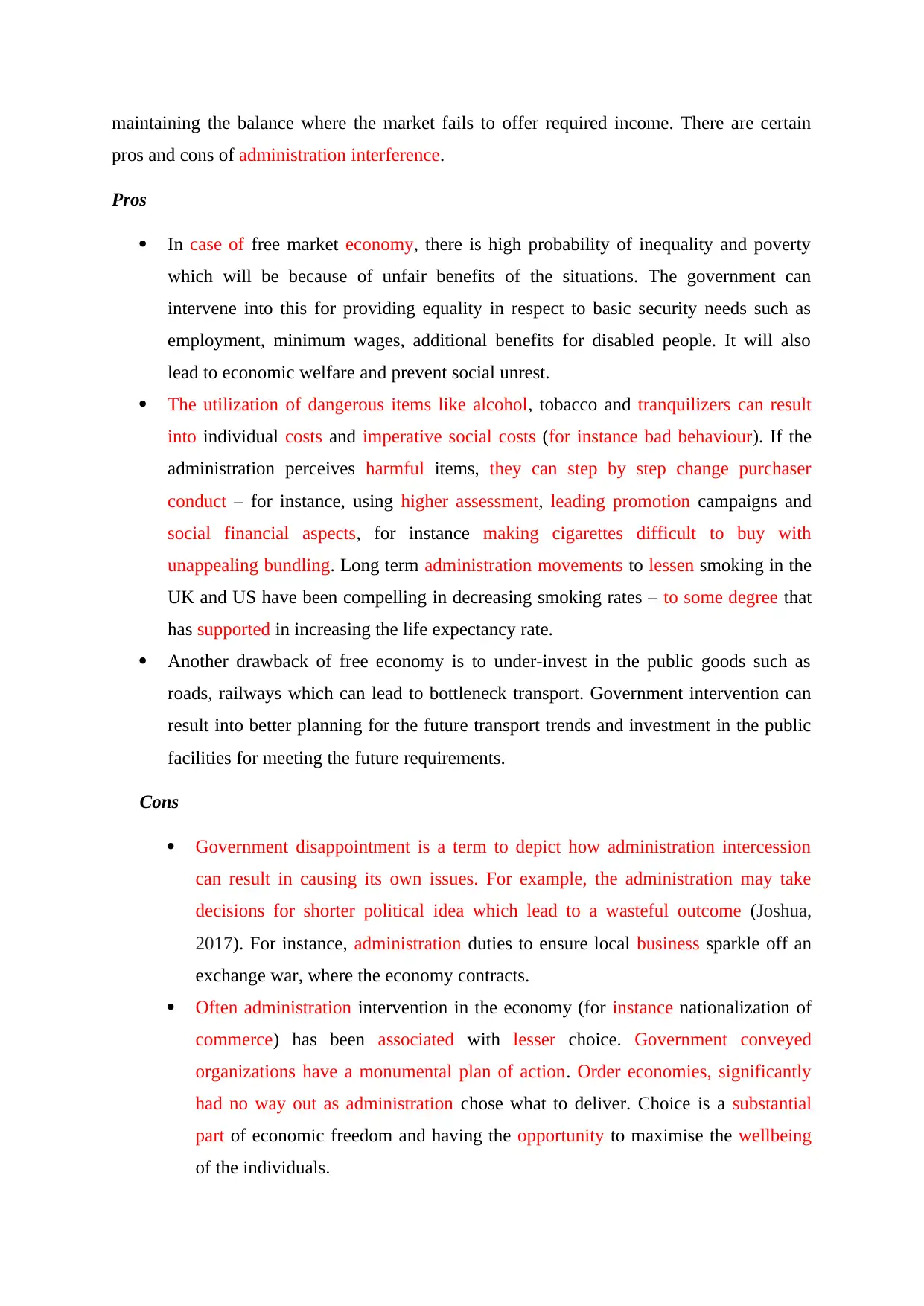
maintaining the balance where the market fails to offer required income. There are certain
pros and cons of administration interference.
Pros
In case of free market economy, there is high probability of inequality and poverty
which will be because of unfair benefits of the situations. The government can
intervene into this for providing equality in respect to basic security needs such as
employment, minimum wages, additional benefits for disabled people. It will also
lead to economic welfare and prevent social unrest.
The utilization of dangerous items like alcohol, tobacco and tranquilizers can result
into individual costs and imperative social costs (for instance bad behaviour). If the
administration perceives harmful items, they can step by step change purchaser
conduct – for instance, using higher assessment, leading promotion campaigns and
social financial aspects, for instance making cigarettes difficult to buy with
unappealing bundling. Long term administration movements to lessen smoking in the
UK and US have been compelling in decreasing smoking rates – to some degree that
has supported in increasing the life expectancy rate.
Another drawback of free economy is to under-invest in the public goods such as
roads, railways which can lead to bottleneck transport. Government intervention can
result into better planning for the future transport trends and investment in the public
facilities for meeting the future requirements.
Cons
Government disappointment is a term to depict how administration intercession
can result in causing its own issues. For example, the administration may take
decisions for shorter political idea which lead to a wasteful outcome (Joshua,
2017). For instance, administration duties to ensure local business sparkle off an
exchange war, where the economy contracts.
Often administration intervention in the economy (for instance nationalization of
commerce) has been associated with lesser choice. Government conveyed
organizations have a monumental plan of action. Order economies, significantly
had no way out as administration chose what to deliver. Choice is a substantial
part of economic freedom and having the opportunity to maximise the wellbeing
of the individuals.
pros and cons of administration interference.
Pros
In case of free market economy, there is high probability of inequality and poverty
which will be because of unfair benefits of the situations. The government can
intervene into this for providing equality in respect to basic security needs such as
employment, minimum wages, additional benefits for disabled people. It will also
lead to economic welfare and prevent social unrest.
The utilization of dangerous items like alcohol, tobacco and tranquilizers can result
into individual costs and imperative social costs (for instance bad behaviour). If the
administration perceives harmful items, they can step by step change purchaser
conduct – for instance, using higher assessment, leading promotion campaigns and
social financial aspects, for instance making cigarettes difficult to buy with
unappealing bundling. Long term administration movements to lessen smoking in the
UK and US have been compelling in decreasing smoking rates – to some degree that
has supported in increasing the life expectancy rate.
Another drawback of free economy is to under-invest in the public goods such as
roads, railways which can lead to bottleneck transport. Government intervention can
result into better planning for the future transport trends and investment in the public
facilities for meeting the future requirements.
Cons
Government disappointment is a term to depict how administration intercession
can result in causing its own issues. For example, the administration may take
decisions for shorter political idea which lead to a wasteful outcome (Joshua,
2017). For instance, administration duties to ensure local business sparkle off an
exchange war, where the economy contracts.
Often administration intervention in the economy (for instance nationalization of
commerce) has been associated with lesser choice. Government conveyed
organizations have a monumental plan of action. Order economies, significantly
had no way out as administration chose what to deliver. Choice is a substantial
part of economic freedom and having the opportunity to maximise the wellbeing
of the individuals.
Paraphrase This Document
Need a fresh take? Get an instant paraphrase of this document with our AI Paraphraser
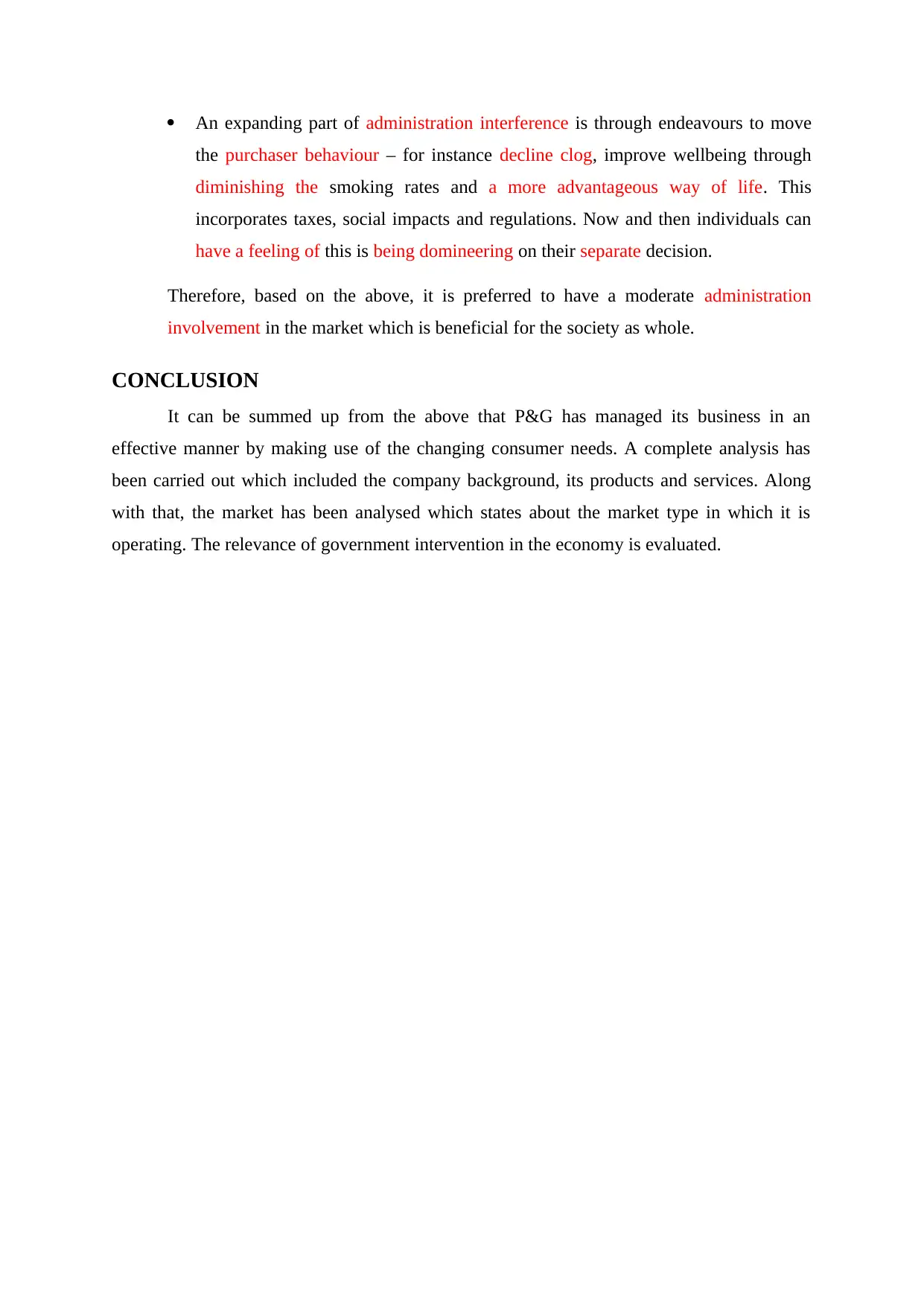
An expanding part of administration interference is through endeavours to move
the purchaser behaviour – for instance decline clog, improve wellbeing through
diminishing the smoking rates and a more advantageous way of life. This
incorporates taxes, social impacts and regulations. Now and then individuals can
have a feeling of this is being domineering on their separate decision.
Therefore, based on the above, it is preferred to have a moderate administration
involvement in the market which is beneficial for the society as whole.
CONCLUSION
It can be summed up from the above that P&G has managed its business in an
effective manner by making use of the changing consumer needs. A complete analysis has
been carried out which included the company background, its products and services. Along
with that, the market has been analysed which states about the market type in which it is
operating. The relevance of government intervention in the economy is evaluated.
the purchaser behaviour – for instance decline clog, improve wellbeing through
diminishing the smoking rates and a more advantageous way of life. This
incorporates taxes, social impacts and regulations. Now and then individuals can
have a feeling of this is being domineering on their separate decision.
Therefore, based on the above, it is preferred to have a moderate administration
involvement in the market which is beneficial for the society as whole.
CONCLUSION
It can be summed up from the above that P&G has managed its business in an
effective manner by making use of the changing consumer needs. A complete analysis has
been carried out which included the company background, its products and services. Along
with that, the market has been analysed which states about the market type in which it is
operating. The relevance of government intervention in the economy is evaluated.
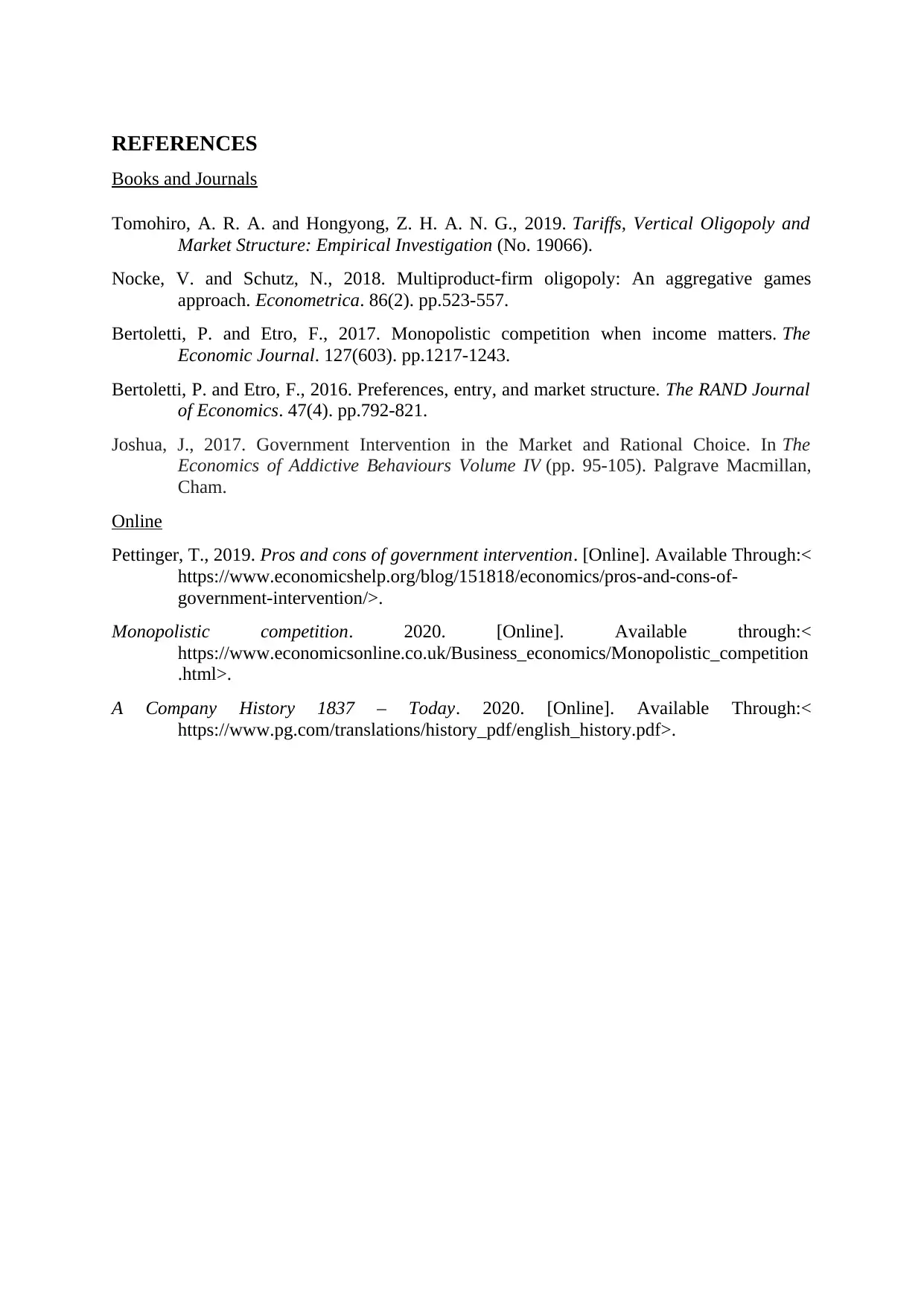
REFERENCES
Books and Journals
Tomohiro, A. R. A. and Hongyong, Z. H. A. N. G., 2019. Tariffs, Vertical Oligopoly and
Market Structure: Empirical Investigation (No. 19066).
Nocke, V. and Schutz, N., 2018. Multiproduct‐firm oligopoly: An aggregative games
approach. Econometrica. 86(2). pp.523-557.
Bertoletti, P. and Etro, F., 2017. Monopolistic competition when income matters. The
Economic Journal. 127(603). pp.1217-1243.
Bertoletti, P. and Etro, F., 2016. Preferences, entry, and market structure. The RAND Journal
of Economics. 47(4). pp.792-821.
Joshua, J., 2017. Government Intervention in the Market and Rational Choice. In The
Economics of Addictive Behaviours Volume IV (pp. 95-105). Palgrave Macmillan,
Cham.
Online
Pettinger, T., 2019. Pros and cons of government intervention. [Online]. Available Through:<
https://www.economicshelp.org/blog/151818/economics/pros-and-cons-of-
government-intervention/>.
Monopolistic competition. 2020. [Online]. Available through:<
https://www.economicsonline.co.uk/Business_economics/Monopolistic_competition
.html>.
A Company History 1837 – Today. 2020. [Online]. Available Through:<
https://www.pg.com/translations/history_pdf/english_history.pdf>.
Books and Journals
Tomohiro, A. R. A. and Hongyong, Z. H. A. N. G., 2019. Tariffs, Vertical Oligopoly and
Market Structure: Empirical Investigation (No. 19066).
Nocke, V. and Schutz, N., 2018. Multiproduct‐firm oligopoly: An aggregative games
approach. Econometrica. 86(2). pp.523-557.
Bertoletti, P. and Etro, F., 2017. Monopolistic competition when income matters. The
Economic Journal. 127(603). pp.1217-1243.
Bertoletti, P. and Etro, F., 2016. Preferences, entry, and market structure. The RAND Journal
of Economics. 47(4). pp.792-821.
Joshua, J., 2017. Government Intervention in the Market and Rational Choice. In The
Economics of Addictive Behaviours Volume IV (pp. 95-105). Palgrave Macmillan,
Cham.
Online
Pettinger, T., 2019. Pros and cons of government intervention. [Online]. Available Through:<
https://www.economicshelp.org/blog/151818/economics/pros-and-cons-of-
government-intervention/>.
Monopolistic competition. 2020. [Online]. Available through:<
https://www.economicsonline.co.uk/Business_economics/Monopolistic_competition
.html>.
A Company History 1837 – Today. 2020. [Online]. Available Through:<
https://www.pg.com/translations/history_pdf/english_history.pdf>.
⊘ This is a preview!⊘
Do you want full access?
Subscribe today to unlock all pages.

Trusted by 1+ million students worldwide
1 out of 12
Related Documents
Your All-in-One AI-Powered Toolkit for Academic Success.
+13062052269
info@desklib.com
Available 24*7 on WhatsApp / Email
![[object Object]](/_next/static/media/star-bottom.7253800d.svg)
Unlock your academic potential
Copyright © 2020–2026 A2Z Services. All Rights Reserved. Developed and managed by ZUCOL.





